Planning June 2019
Curb Control
Parking is so passé. Swiftly changing mobility options and competing priorities mean planners need to practice active curb management.
By Brian Barth
In today's urban fabric, few spaces are more contested than the curb.
No longer taken for granted, it seems like everyone is vying for access to that thin ribbon of limited real estate. Amid the timeless curbside ballet of cars parking; pedestrians moving from point A to point B, some with strollers or in wheelchairs; and street vendors selling their wares, new dancers are looking to cut in.
Ride-hailing services now clamor for pickup and drop-off zones. Delivery companies need a place to park while their drivers dash to your door with that pair of new sneakers (or a steaming bowl of noodles). Car-share companies want space for vehicle stations. Cycling advocates want bike lanes and bike share docks. Environmentalists want stormwater swales and electric vehicle charging stations. More recently, dockless bikes and scooters have only added to the chaos.
All this new activity swirls around, and in some cases overlaps with, the old-fashioned use for the curb — car parking — which was already plenty argued over.
"We're in the midst of a big generational change," says Jason Schrieber, AICP, a transportation planner at Stantec, a private consulting firm. "Millennials, post-millennials, even some Gen Xers, will jump in an Uber, find a bike share, jump on an e-scooter — things that are accessed at the curb, instead of in some underground garage or out back in the parking lot."
Curbs, Schrieber says, are quickly evolving from repositories for a single smog-emitting mode into hyperlocal transportation terminals, with a variety of transportation modes zipping in and out. "Curb demand in this new era is changing from cars, and particularly car storage, to people and active mobility."
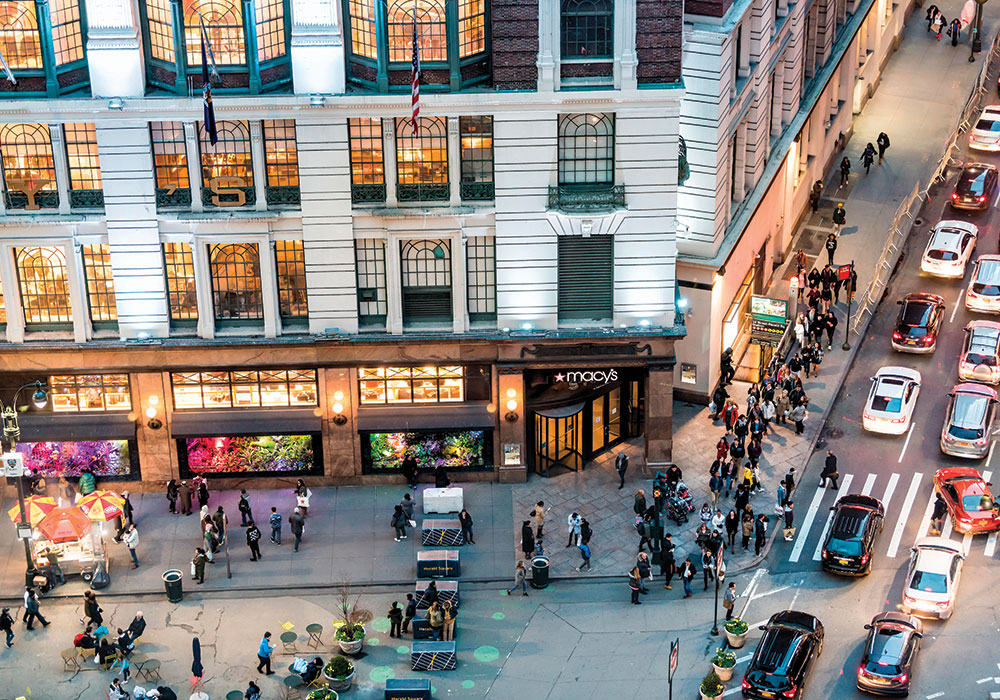
Every day, taxis, TNC vehicles, private cars, subway riders, and throngs of pedestrians jockey for curbside space outside Macy's Herald Square in New York City. Photo by Andriy Blokhin/Alamy.
Who Wants a Piece of the Curb?
Basically, everyone. And in balancing these competing demands, ADA requirements and other accessibility considerations should be paramount.
Drivers (including TNC)
Pedestrians (including drop-offs)
Mobile Vendors
Emergency Services
Parked Vehicles and Electric Vehicle Charging
Couriers and Delivery Vehicles
Transit and Transit Infrastructure
Taxis, Transportation Network Companies, and Shuttles
Bicycles and Bicycle Infrastructure
Local Businesses
Parklets and Other Streetscape Elements
Source: Curbside Management Practitioners Guide
Curb dialogues
To illustrate the social costs of the nation's growing curbside chaos, Greg Rogers, director of government relations and mobility innovation at Securing America's Future Energy — and a former Uber driver — has written about what he calls "the Double Park Shuffle": the daily traffic dance of TNC (transportation network company) drivers. He lists four less-than-graceful steps:
- A car with an Uber or Lyft logo (or perhaps both) slows down near the middle of a block.
- The TNC driver takes their eyes off the road to look for the passenger and/or a place to pull over.
- Failing to find either the passenger or a parking spot, the TNC driver flicks on their hazard lights and stops the car.
- An entire lane of traffic comes to a dead halt; cyclists must weave between the TNC car and parked cars; horns honk; rude gestures are made; and everyone's blood pressure rises.
Multiply this by the four billion-plus TNC rides made daily in the U.S., a number that is growing exponentially, and you get a sense of the profound changes, not to mention dangers, at play. In San Francisco alone, TNC companies now account for about one in five vehicles on the road, and two-thirds of traffic violations.
The delivery truck situation is similar. In the past 10 years, the increase in e-commerce caused delivery truck traffic to double — there's currently one internet-based delivery a day per 25 Americans — and it's expected to double again in the next five years. A study by the University of Washington's Urban Freight Lab found that delivery trucks in downtown Seattle double-park, or otherwise park illegally, for about half of delivery stops. In Washington D.C., UPS pays more than $1 million in parking fines annually. Given the brisk pace of the e-commerce delivery business, the fines are apparently not stiff enough to encourage greater compliance. But the costs of congestion, including tailpipe emissions from cars idling or circling for a place to park, must somehow be accounted for.
According to Schrieber, curb space in high-demand areas could be up to 30 times more valuable if reconfigured from typical paid parking to flexible pickup and drop-off terminals that accommodate rapid-fire movement of multiple transportation modes. In other words: 30 times the municipal revenue and 30 times greater trip capacity.
"That metric says we could have a lot more going on in the curb lane if it's all at a very short interval," says Schrieber. The problem, he adds, is that transportation planning still relies on old models that calculate trip and parking demand on an hourly or daily basis.
Transportation planners are currently in the throes of figuring out how to update their methods to think about curb use on a minute-by-minute scale. Of course, any discussion about what's happening on the curb must start with what's happening beyond it, says Schrieber. "The fundamental point for planners is the hugely symbiotic relationship between a curb and the land uses it serves."
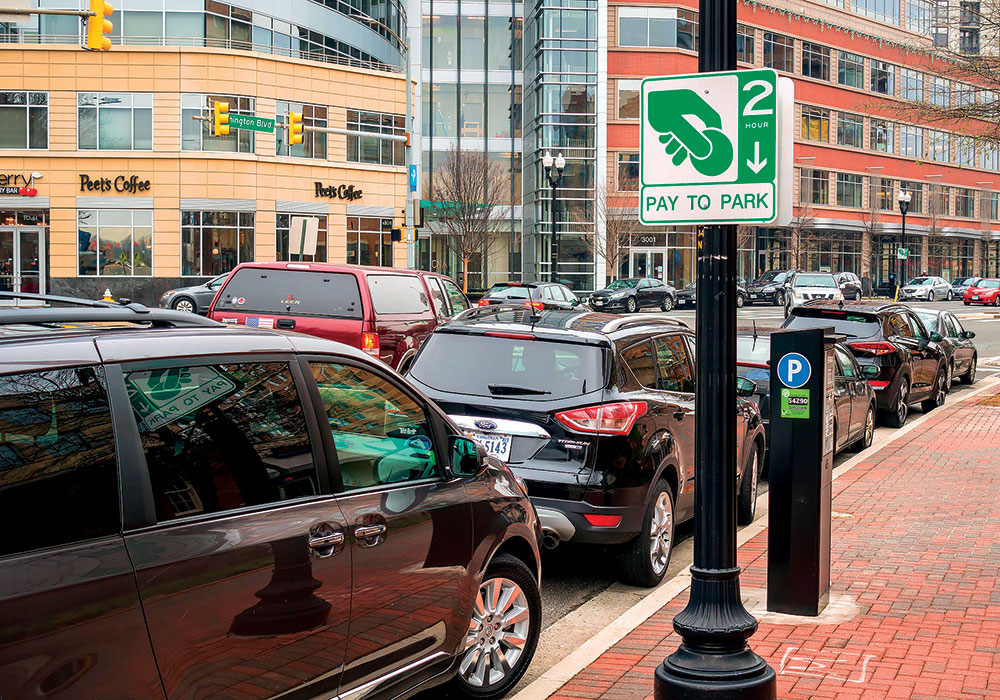
Hyperlocal Transportation Terminals: Curbs are evolving from places to merely park cars — as in Arlington, Virginia — into individual multimodal hubs, with a variety of modes zipping in and out. A single parked car curbside simply can't compete with the capacity potential of taxi and TNC rides, transit stops, and bike lanes. Photo by Rob Crandall/Alamy.
Mapping the problem
Cities have extremely detailed maps and data on land use; curb use, not so much. At present, the location of every parking meter, parking space, sign, curb marking, bollard, and bit of street furniture is likely found somewhere in a city's archives, but it would be much easier to make decisions about changes in curb use if that information were integrated in a single GIS system. As curb management becomes a pressing priority, the race to digitize the space between sidewalk and street is under way.
A few companies are developing tools to that end. One is Coord, an offshoot of Sidewalk Labs, a Google sister company. Its Surveyor tool employs augmented reality technology to quickly collect curb data through an iPhone app and transfer it to a central database. Users can walk down a street with the camera-based app open and mark curb conditions and infrastructure on the screen as they go. CEO Stephen Smyth says the process is about six times faster than older manual methods and can digitize a block of curb in under three minutes.
Coord's Curb Explorer tool then displays the data on a map interface that is tied to relevant parking, traffic, and land-use regulations. With a few keystrokes, you can pull up all the locations, say, where commercial vehicles can park to unload goods in a given neighborhood at 9 a.m. on a Tuesday. Hundreds of curb miles in New York, San Francisco, Los Angeles, and San Diego have been digitized so far.
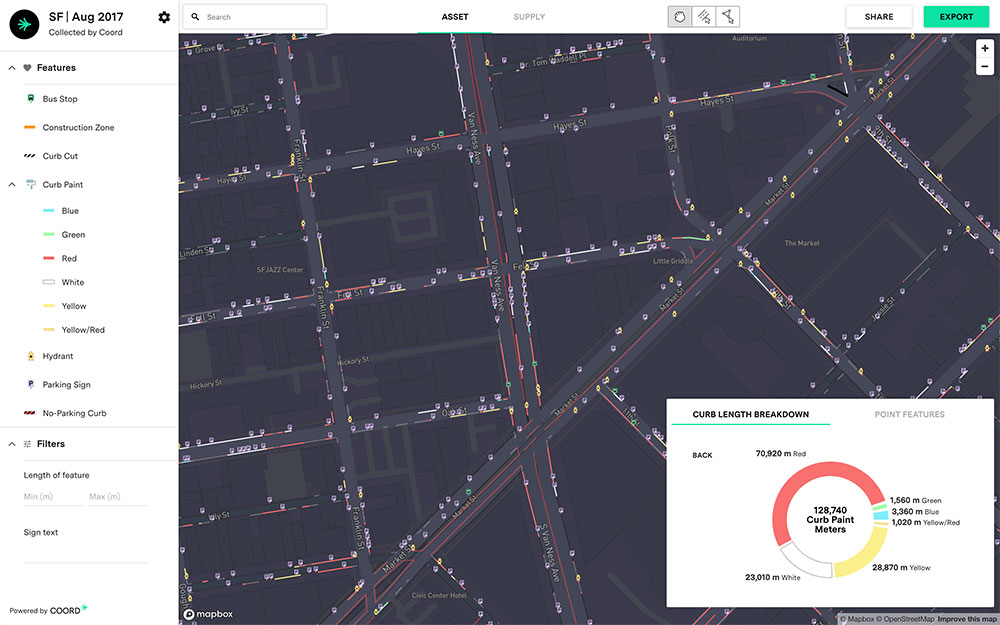
Map It to Manage It: Technology can help cities and planners understand the rules of the road. Coord Analytics's platform, with a new version out June 1, lets users see the rules that apply to a particular curb by day, time, and vehicle type; measure curb space allocated to different uses (e.g., passenger pickup, deliveries, and parking); and assess how parking capacity and pricing vary across an area, as in this example from San Francisco. Image and map courtesy Coord.
The vision, he says, is "a curbside management platform" with "real-time information about the usage of that space — the permitted uses and the actual uses." The platform will be made available to both local government and fleet services (e.g., Uber and UPS) through an API.
Another player is Allvision. Based in Pittsburgh, it also captures data in real time, in this case with the use of autonomous vehicles and robotics equipped with Lidar equipment. In its curb platform, Allvision Parkview, that 3-D data is aggregated with other sources and analyzed using machine learning and cloud computing to deliver "ingestible data to inventory, track, and monitor your curb real estate and its assets," according to its website.
"Our mission," says CEO Aaron Morris, "is to turn 3-D data into digital twins of everything visible from the sidewalk, road, or rail."
Technologies like these will make it possible to answer seemingly straightforward questions, like the number of parking spots in a given part of a city, as well as tougher questions like managing commercial deliveries citywide, giving planners "all kinds of other ways to slice and dice curb space supply," says Coord's Smyth.
Buried within all this are even bigger, politically charged questions: Where should standard street parking be restricted, or eliminated, to make way for other curb uses? What circumstances would justify it? By what process is that decided?
The social and economic implications of switching to a terminal model of curb use remain fuzzily defined, but one thing is clear: "Cities are getting a lot of pressure to convert private car parking into a variety of other things," says Smyth.
Robust data can fuel the decision-making process, make it more transparent, and encourage stakeholder buy-in. A technology platform could then flesh out some of the details, like setting appropriate rates for a TNC pickup or drop-off that may last 30 seconds or a commercial delivery that might last 30 minutes. It could even be used to collect payment.
Curbside Capacity by the Block
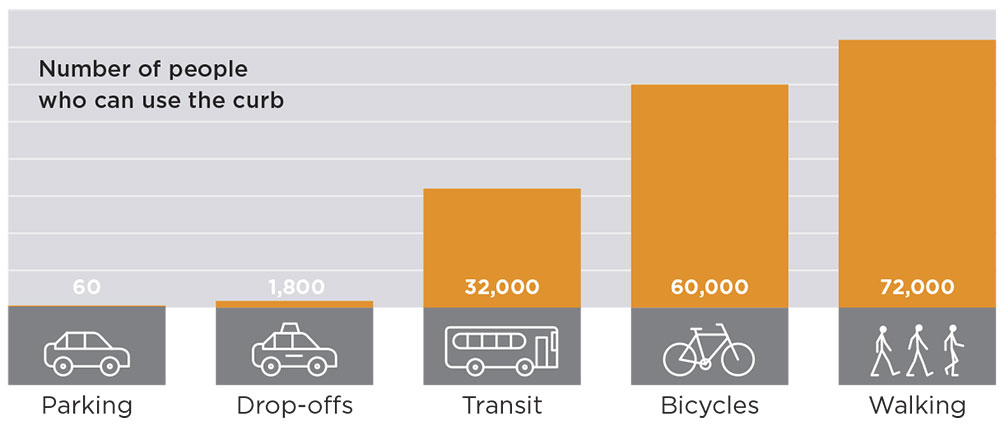
Graphics by Haisam Hussein; graphs courtesy Stantec's Urban Places, based on NACTO data.
A Parking Space in Time

Graphics by Haisam Hussein; graphs courtesy Stantec's Urban Places, based on NACTO data.
Beyond the curb
Tangents to the curb discussion are many. Wheeled robots, drones, and electric cargo tricycles may soon reduce the number of diesel-spewing delivery trucks hogging the curb (all three are already in use on a limited scale). Less high-tech and more widespread are delivery lockers, where goods are dropped off at a central neighborhood location, helping to curtail the double-parking shuffle (a study by Urban Freight Lab found that an installation of lockers at an apartment tower in Seattle reduced the time UPS trucks were parked out front by 70 percent).
Curbless streets are another approach. For its smart city project in Toronto, Sidewalk Labs is pitching a continual plane of pavers for both sidewalk and street, which could be illuminated in different colors and configurations to delineate changing uses. Signless, marking-free woonerfs — the Dutch term for curbless streets — are increasingly popular as a self-regulating approach to managing multimodal chaos.
But ideas about curb management don't mean much if they're not applied in the context of public interest and community-specific needs and values.
For example, demand-based curb pricing could produce much-needed municipal revenue — but what will it be allocated to and what stands to be lost in the process? At present, this trend is largely driven by TNC companies who stand to profit from increased curb access, even if they have to pay for it. Yet it's increasingly accepted that the recent increase in TNC ridership is responsible, at least in part, for a nationwide decrease in transit ridership — a study by Boston's Metropolitan Area Planning Council found that 42 percent of TNC trips replaced a transit trip — meaning that allocating greater curb space to ride-hailing services effectively disincentivizes investment in mass transit.
Given that mass transit is the more affordable mobility option for low-income residents, and has substantially lower greenhouse gas emissions, this would seem to be the wrong direction for curb management. Repurposing curb parking for other uses is clearly wise from both equity and environmental perspectives, however, so if TNCs can serve as a revenue-generating part of that equation, perhaps they can, in the end, bolster the greater good.
A traditional metered parking space typically serves just 15 vehicles per day, according to the National Association of City Transportation Officials, while a bus stop can serve 1,000 passengers. Half of the trips Americans make each day are less than three miles in length, yet 72 percent of those are made by car. Freeing up curb space for bike shares and scooters could help free us from the reflex of jumping in a vehicle each time we need to run an errand nearby. The more street parking that is removed, the more space there is for dedicated bus and bike lanes, and potentially for pedestrians, tree plantings, and green infrastructure for stormwater management. Demand-based curb pricing could be the key to healthier, more "complete" streets, but only if we plan it that way.
Finn Swingley, a business and solutions architect at HERE Technologies, a large "location services" platform serving the transportation and logistics industries, concurs: "There's different types of efficiencies involved in curb management that need to be traded off against each other. We need to measure not just the monetary or transactional aspects, but the public good."
The Curb as a Shared-Mobility Transit Hub
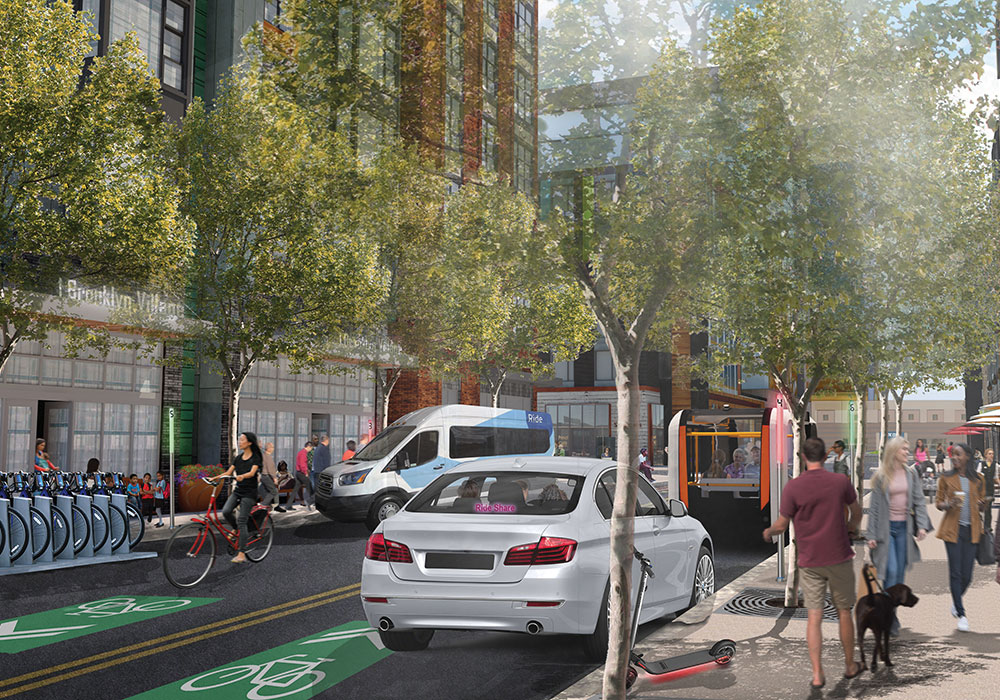
Rendering courtesy Stantec's Urban Places.
Shared-use mobility zones are an emerging concept that encourages eliminating small sections of street parking in a given area and refashioning them as multiuse and multimode "terminals" at the beginning or end of blocks. The full SUM vision may one day be a commonplace reality, but for now, cities are getting their feet wet with simple initiatives that could lead the way to more dynamic curb management. Curbside flex zones, like those shown below, can play many roles — from public space to loading zones — and can change use over the course of the year, week, or even day.

Morning — 6 a.m. to 11 a.m.: Before the peak of the morning rush, freight deliveries arrive to stock stores with their goods for the day. By 7:30 a.m., delivery vehicles give way to vehicles dropping off employees, many enjoying breakfast or coffee in a parklet on their way to work. Graphic by Haisam Hussein based on NACTO data.

Midday — 11 a.m. to 4 p.m.: Late morning brings package and mail deliveries to businesses and residents. At noon, the lunch rush begins, and workers head to street vendors for their midday meals. By 2 p.m., most diners are back inside and light delivery activity continues until the evening rush. Graphic by Haisam Hussein based on NACTO data.

Evening — 4 p.m. to midnight: The evening rush stops delivery activity as street and vehicle capacity is shifted to move people instead of goods. Passenger movement continues into the evening as people grab dinner or drinks, pick up children, or head to events. Automated evening and late-night delivery activity allows for easy movement of large goods on underused streets. Graphic by Haisam Hussein based on NACTO data.

Nighttime — midnight to 6 a.m.: Late at night the curb prioritizes freight vehicles. Passenger movement is at a minimum through the early hours of the morning, leaving more curb space for delivery services. Nearby storage lockers increase package delivery efficiency. In the morning, freight makes way for transit vehicles. Graphic by Haisam Hussein based on NACTO data.
Big vision, baby steps
Shared use mobility zones are an emerging concept that encourages eliminating small sections of street parking in a given area and refashioning them as multiuse/multimode "terminals" at the beginning or end of blocks. The full SUM vision may one day be a commonplace reality, but for now cities are getting their feet wet with simple initiatives that could lead the way to more dynamic curb management.
Designated ride-share pickup and drop-off zones are among the low-hanging fruit for curb interventions. Among the cities experimenting with this approach is Washington, D.C., where curb parking in the nightlife district along Connecticut Avenue has been redesignated for that purpose from Thursday to Saturday nights starting at 10 o'clock. The three-block area, which boasts roughly 100 bars with a combined capacity of more than 17,000 people, had been served by just 60 parking spaces, leaving patrons to stumble into the street after a night of partying to meet double- and triple-parked TNC rides. Now they can meet their ride safely at the curb.
Demand-based metered parking is another trend taking root. In 2010, Seattle began surveying parking space occupancy on an annual basis and adjusting rates up or down (as well as changing the permitted duration and hours of availability) in an effort to even out supply and demand. The goal is to find an equilibrium where one to two spaces remain open on each block at any given time, the equivalent of 70 to 85 percent occupancy. A social media campaign helped spread public awareness about the project, while online maps inform residents about rate information; a "best value" icon on parking signs points drivers to places where it is cheaper to park, but perhaps a bit farther to walk to their destination.
Mary Catherine Snyder, a parking strategist with the Seattle Department of Transportation, says that nine years later, hundreds of minor changes to parking regulations have been made, and the targeted occupancy rate has started to become the norm in neighborhoods where it was once notoriously difficult to park.
"In 2010, we had three parking rates across the city and now we essentially have 90," says Snyder. "Now we're working on how to apply that approach to things like urban goods delivery and ride hailing and all the other expanding uses of the curb."
This year, for example, the city rolled out a pilot program to convert on-street parking to fee-based commercial loading zones in select high-demand areas, but only from 6 to 11 a.m. — hours when street parking demand in those areas is relatively light.
"Freight delivery companies are going to stop where they need to stop because they have to deliver their packages, and if we're not accommodating and managing that, they're going to stop where we don't want them to," says Snyder.
Snyder says that the difficulty of collecting reliable data remains a roadblock to making more complex changes to curb management. App-based parking payment systems are one readily available avenue to amass digitized parking data, but Snyder says that in Seattle only about 35 percent of parking transactions occur through the city's app. And she points out that people who park without paying, a widespread issue, skew any data collected.
To get around these constraints, cities including San Francisco and Los Angeles have experimented with sensors that can detect parking behavior on a real-time basis. And the "smart parking" company Streetline offers machine learning software that can derive parking data from the video feeds that have become a fixture in high-density urban environments.
Beyond SUM zones and demand-based curb pricing, one can imagine a future where curb management becomes a tightly choreographed ballet of urban mobility, orchestrated by a symphony of technologies. Perhaps curb metering will advance to become more like the systems for real-time highway congestion pricing now being vigorously debated across the globe.
As autonomous vehicles enter the picture, perhaps humans would no longer need to make decisions about who gets to use the curb when and for how steep a price — algorithms would deliver us where we need to go, in concert with sneakers and steaming noodle bowls, with maximum efficiency, our credit cards charged accordingly.
That day may eventually arrive, but Snyder says that in the meantime, cities have tough choices to make as they endeavor to take tiny steps in that direction. "It will require a lot of expensive infrastructure to get to real-time congestion pricing where your car knows where you are, records the three minutes that you're at the curb, and the system sends you a bill. And then there's the policy aspects of implementing that. I'm a big proponent of digitizing the curb and pricing it, but a lot of technology is still conceptual at this point."
Right now, she says her goal is simply to "make parking a little more automated so people spend less time circling to find parking" — a worthy cause, given that Americans spend an average of 17 hours per year looking for parking.
Brian Barth is a freelance journalist with a background in urban planning. He lives in Toronto.


